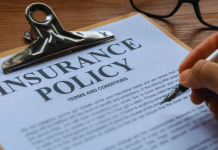“What is insurance and why is it important” is a crucial question that many people have. Insurance is a contract between you and an insurance company that helps you to cover the costs of unexpected events such as accidents, illnesses, or damage to your property.
It’s a form of protection against financial loss. In this blog, we will help you understand what is insurance and why is it important. One of the most important reasons why insurance is important is that it helps to protect you and your loved ones from financial ruin in case of an unexpected event such as an accident, illness, or natural disaster.
It’s a small price to pay for peace of mind and protection against financial loss. This blog will provide you with all the information you need to know about insurance, including the different types available, how it works, and how to choose the right policy for you.
Different Types of Insurance
Auto Insurance
Driving without full auto coverage insurance is illegal in most states and can be costly if you get into an accident. There are various types of car insurance that can cover damage and injuries, this includes the following:
- Liability coverage: Comprehensive auto liability insurance covers property damage and injuries caused to others in an accident for which you are at fault. It also pays for legal defense and judgments or settlements if you are sued. It is mandatory in most states.
- Uninsured/underinsured motorist (UM) coverage: Uninsured motorist coverage pays for medical expenses and lost wages for you and your passengers in case you are hit by an uninsured or underinsured driver. It may also cover damage to your car in some states. It is mandatory in some states and optional in others.
- Personal injury protection (PIP): PIP insurance covers injuries to you and your passengers in an accident, regardless of fault. It also covers lost wages, rehabilitation costs, and services like child care you can no longer perform after being injured. It is mandatory in some states, optional in others, and not available in some states.
- Medical payment coverage: MedPay coverage helps pay for medical expenses for you and your passengers in case of an accident, regardless of fault. Coverage amounts are typically low, usually between $1,000 and $5,000.
- Comprehensive and collision coverage: Collision and comprehensive insurance cover damage to your vehicle. Collision insurance covers damage from an accident, regardless of fault. Comprehensive insurance covers damage from theft, floods, hail, fire, vandalism, falling objects, and animal strikes. They are often sold together and are optional, but mandatory if you finance or lease your car.
Home Insurance
Comprehensive home insurance coverage is not mandatory by state law, unlike auto insurance. However, if you financed your home, your lender will typically require coverage to protect their interest in the property.
This ensures that if your home is damaged or destroyed, you have the funds to rebuild and will not default on your mortgage. Even if you own your home outright, it’s wise to have home insurance to cover the cost of repairs or replacement if your home is damaged or destroyed.
Home insurance policies have several types of coverage, including:
- Dwelling coverage: Dwelling coverage protects the structure of your house from events such as fire, wind, theft, and vandalism. It also covers structures attached to your property, such as a garage or deck. The coverage amount should equal the cost of rebuilding your house.
- Personal property coverage: Personal property coverage protects your personal belongings such as furniture, appliances, and clothing from theft, fire, and explosions. Coverage is usually set at an amount between 50% and 70% of your dwelling coverage and can be increased if needed.
- Other structures on the property: Other structures coverage covers structures on your property such as a tool shed or fence.
- Liability coverage: Liability insurance covers injuries or property damage caused accidentally by you to others and also covers attorney fees if someone sues you. The coverage amount should equal your net worth or what could be taken from you in a lawsuit.
- Additional living expenses: Additional living expenses coverage pays for extra costs such as meals and lodging if you are temporarily displaced from your home due to damage covered by your policy.
Remember that standard home insurance policies do not cover damage from floods or earthquakes, separate insurance is available for these risks.
Renters Insurance
Even if you don’t own a home, you still need insurance. Comprehensive renters insurance covers the replacement of your belongings such as electronics, furniture, and clothing if they are stolen or damaged due to events like fire, tornadoes, explosions, and more.
Without renters insurance, you would be responsible for replacing your belongings in case of damage or loss to the rental property. The landlord’s insurance covers the structure of the rental but not the tenant’s property. Some landlords may require proof of coverage before renting a unit.
Renters’ insurance includes:
- Personal property coverage: Personal property coverage protects your possessions such as furniture, clothing, and dishes from theft or damage caused by events like fire.
- Liability coverage: Liability insurance covers the cost of injuries or property damage that you are liable for. For example, if someone is injured due to your negligence in your rental, liability insurance will cover their medical expenses.
- Additional living expenses coverage: Additional living expenses coverage pays for additional costs such as lodging if your rental becomes uninhabitable due to damage covered by your policy.
Umbrella Insurance
Liability coverage included in auto, home, and renters insurance protects your assets from lawsuits but has limits. If you have significant assets, these limits may not be enough in the event of a costly lawsuit.
Umbrella insurance offers additional liability coverage in unexpected situations where you may be held liable. For instance, if someone sues you for $500,000 in medical expenses after an injury on your property, and your home insurance liability limit is only $300,000, umbrella insurance can cover the remaining $200,000.
Life Insurance
Having dependents who rely on you financially makes it crucial to find the appropriate life insurance for your circumstances. Research from industry-funded firm LIMRA shows that 44% of US households would experience financial difficulty within six months if the main breadwinner died, and for 28%, it would be just one month.
Comprehensive life insurance can serve as a replacement for your income in case of an unexpected death. Life insurance policies come in two main types: term life insurance and permanent life insurance.
Term Life Insurance
Term life insurance allows you to secure a rate for a specific period, such as 10, 15, 20, or 30 years. During this time, your premiums remain the same. Once the term ends, you can usually renew the policy annually, but the cost will increase with each renewal.
If you need coverage to fulfill a specific financial obligation, like paying for college or a debt, term life insurance may be a suitable option. It is typically the most affordable type of life insurance.
Permanent Life Insurance
Permanent life insurance offers coverage for your entire life. In addition to the death benefit, it includes a cash value component. This cash value can be accessed by taking a loan or withdrawing funds, or if you decide to end the policy, you can take the cash value minus any surrender charge.
Permanent life insurance may be a good choice if you want to build cash value to supplement retirement savings or provide a long-term death benefit for someone who relies on you financially. However, it is more expensive than term life insurance.
Health Insurance
According to the American Public Health Association, medical expenses are a common source of financial struggles in the United States. Even a short hospital stay can cost a substantial amount, with costs reaching $30,000 for a three-day stay. Those without insurance may face severe financial difficulties as a result.
One common way to obtain health insurance is through an employer. However, if your employer does not provide coverage or if you are without employment, you can purchase a plan through the federal health insurance marketplace. These plans may also offer financial assistance for those who meet certain income and eligibility criteria.
Disability Insurance
Many people believe that disability insurance is only necessary for those with dangerous jobs. However, most disabilities are not work-related. The Council for Disabilities Awareness states that common causes of disabilities include arthritis, cancer, diabetes, and back pain.
Disability insurance is a type of coverage that can provide financial support in case of illness or disability that prevents you from working. It typically pays out a percentage (40-70%) of your base income and often has a waiting period before benefits start and a limit on the amount paid out each month.
In addition to being eligible for Social Security disability benefits, there are two primary options for obtaining disability insurance:
- Group disability insurance through work
- Individual disability policies that you purchase on your own
Long-Term Care Insurance
The Department of Health & Human Services states that adults reaching age 65 have a high probability of requiring long-term care, whether it be in-home assistance or a stay in a nursing home.
The cost of long-term care can be significant, with the average monthly cost for a private room in a nursing home being $9,000, according to Genworth, a provider of life and long-term care insurance.
Long-term care insurance can aid in paying for expenses such as in-home care, adult day care, or nursing home stays. The optimal time to purchase long-term care insurance is when you are in your 50s or 60s, as it is generally the most cost-effective. The cost of LTC insurance increases as you get older.
If you are purchasing life insurance, you may have the option to add long-term care coverage as a rider on your policy or buy a policy that combines both life insurance and LTC coverage.
How Insurance Works
Premium
Insurance comes with a cost, and when you first start buying insurance, you may come across a term called “premium.” The premium is the amount that an individual or business pays for coverage such as auto, home, health care, or life insurance.
The calculation of insurance premiums often has a base amount. Depending on your personal information and location, you may be eligible for discounts that will reduce the base premium. To obtain preferred rates or lower insurance premiums, additional information is typically required.
Factors Determine that Insurance Premium
1. Type of Coverage
Insurance companies offer various options. The more coverage you select or the more comprehensive the coverage, the higher your insurance premium may be.
For instance, when comparing premiums for home insurance, if you opt for open peril or all-risk coverage policy, it will be more expensive than a named perils policy that only covers the basics.
2. Amount of Coverage and Your Insurance Premium Cost
Regardless of whether you are buying life insurance, car insurance, health insurance, or any other insurance, you will always pay a higher premium for higher amounts of coverage.
This concept can be applied in two ways. The first is straightforward, and the second is a bit more complex but can help you save on your insurance premiums:
First, the amount of coverage can be adjusted by the dollar value you want on the item you are insuring. For example, insuring a house for $250,000 will differ from insuring a house for $500,000. The more dollar value you want to insure, the more expensive the premium will be.
Second, you can pay less for the same amount of coverage by choosing a policy with a higher deductible. For example, with car insurance, you may be able to save up to 25% by increasing your deductible from $500 to $1,000.
In the case of health insurance or supplemental health policies, you can opt for higher deductibles or look at policies with different options, such as higher copays or longer waiting periods.
3. Personal Information of the Insurance Policy Applicant
Your insurance history, where you live, and other life factors are used to calculate your insurance premium. Every insurance company uses different rating criteria.
Some companies use insurance scores, which are based on various personal factors such as credit rating, car accident frequency, personal claims history, and occupation. These factors can often result in discounts on an insurance policy premium.
Other risk factors specific to the person being insured will also be considered for life insurance, such as age and health conditions.
4. Competition in the Insurance Industry and Target Area
If an insurance company targets a specific market segment, it may adjust rates to attract new business. This can greatly impact rates on a temporary or permanent basis, depending on the success of the insurance company in that market.
Deductible
A deductible is an amount you must pay for covered health care services before your insurance plan begins to pay. For example, if you have a $2,000 deductible, you would pay the first $2,000 of covered services yourself.
After reaching the deductible, you typically only pay a copayment or coinsurance for covered services while your insurance company pays the rest.
- Some insurance plans may cover certain services, such as checkups or disease management programs, before you have met your deductible. It’s important to review the details of your plan.
- All health plans purchased through the Marketplace are required to cover the full cost of certain preventive benefits before the deductible is met.
- Some plans have a separate deductible for specific services such as prescription drugs.
- Family plans often have both an individual deductible, which applies to each person individually, and a family deductible, which applies to all family members collectively.
Generally, plans with lower monthly premiums have higher deductibles, while plans with higher monthly premiums tend to have lower deductibles.
Copays and Coinsurance
Coinsurance is a percentage of covered medical expenses that you pay after reaching your deductible. Your insurance plan pays the remaining portion. For instance, if you have an “80/20” plan, it means the plan covers 80%, and you pay 20% until you reach your maximum out-of-pocket limit.
It’s important to note that coinsurance only applies to covered services. If you have expenses for services not covered by the plan, you will be responsible for the entire cost. If you are unsure what your plan covers, it’s best to review your benefits booklet or contact your plan provider.
Copays, or copayments, are fixed amounts you pay to your medical provider when receiving services. Copays typically start at $10 and vary depending on the type of care you receive. Different copays usually apply to office visits, specialist visits, urgent care, emergency room visits, and prescriptions.
Choosing the Right Insurance
1. Assess Your Life Insurance Goals
Life insurance goals can vary from person to person, and selecting a policy that aligns with your specific goals is important. If your primary goal is to secure your family’s financial stability, a long-term coverage plan with affordable coverage may be a suitable option.
Suppose you have other financial goals, such as saving for your child’s education or buying a dream home. In that case, you may consider investing in a unit-linked insurance plan or a retirement plan to ensure regular income post-retirement.
2. Calculate the Optimal Insurance Cover that You Need
Many financial advisers recommend that your life insurance coverage should be at least ten to fifteen times your annual income. However, there are other factors to consider when determining the ideal coverage amount.
These include debts, the cost of repaying mortgages, future expenses such as your child’s education or wedding, and the number of years for which income replacement may be necessary. To determine the ideal coverage amount, you should calculate the total of the following:
- Your family’s annual expenses are multiplied by the number of years for which income replacement might be necessary.
- The total amount of your outstanding debts and the cost of repaying mortgages, if any.
- The amount you need to set aside for future expenses such as your child’s education and wedding.
3. Determine the Amount You Have to Pay as the Premium and Find the Policy Offering the Best Deal
To determine the premium you need to pay for a specific amount of life insurance, you can use online premium calculators. Compare different plans to find a policy that offers the highest coverage at rates that fit your budget.
Additionally, consider the length of time you will need to pay the premium based on your earnings for the upcoming years.
4. Select the Correct Policy Term
The term of the policy should ideally be the number of years your family will be financially dependent on you. A general rule of thumb for determining the ideal policy term is to subtract your current age from the age at which you expect your income to stop or wish to accomplish a specific life goal.
5. Opt for a Reputable Life Insurance Provider
Life insurance companies with a claim settlement ratio (CSR) of over 95% for consecutive years are generally considered reliable. The CSR is the percentage of claims that the company has settled in a financial year compared to the number of claims placed.
You can check the CSR of different insurance providers in India on the Insurance Regulatory and Development Authority (IRDAI) website. Additionally, it’s advisable to read customer reviews and ensure that the life insurer’s claim service is fast and hassle-free.
6. Do Not Conceal Facts From Your Life Insurance Provider
If you consume tobacco or alcohol, work in a hazardous industry, or have any pre-existing illnesses or family history of critical illnesses, inform your life insurer.
These factors will influence your risk profile, and providing accurate information is vital to prevent claim rejection in the future.
7. Read the Final Policy Document Carefully
Understand all the terms and conditions clearly before making a final commitment. Find out relevant details, such as the lock-in period and the circumstances in which the claim will not be valid.
8. Buy Life Insurance at an Early Age
Life insurance premiums are lower when you are younger, so you can save on the cost of your premium by buying a policy as soon as you start earning. You can start with lower coverage and add more riders as your income increases.
9. Choose a Comprehensive Plan
Medical emergencies can have a negative impact on your income, so it’s important to choose a comprehensive plan with appropriate riders to protect yourself:
- A Critical Illness rider provides a full claim payout if you are diagnosed with a serious medical condition, such as kidney malfunction, cancer, or heart disease. This can help cover treatment costs and protect you against loss of income.
- An Accidental Death Benefit rider provides an additional amount to your loved ones in case of sudden death due to an accident. This can help safeguard your family’s future and maintain their current lifestyle.
- A Permanent Disability rider waives all future premiums if you are permanently disabled due to an accident. Your life coverage continues throughout the remaining policy term.
- A Terminal Illness rider provides access to funds to deal with terminal illnesses such as cancer by providing a full payout before death.
It is important to choose an insurance provider that offers these benefits without any hidden fees.
10. Evaluate Your Life Insurance Needs Regularly
It is important to periodically evaluate your life insurance needs as your financial goals may change with age and life events such as marriage or having children.
By regularly reviewing and updating your coverage, you can ensure that your coverage stays aligned with your current needs and take into account the effects of inflation.
Protect Your Future: What is Insurance and Why is it Important
Insurance is an important form of protection against financial loss. It helps to protect you and your loved ones from the financial ruin that can result from unexpected events such as accidents, illnesses, and natural disasters.
We encourage you to take the time to review and update your insurance coverage. Make sure that you have the right types of insurance, that your policies are up to date, and that you’re getting the best rates possible. By taking these steps, you can rest assured that you and your loved ones are protected in case of an unexpected event.










